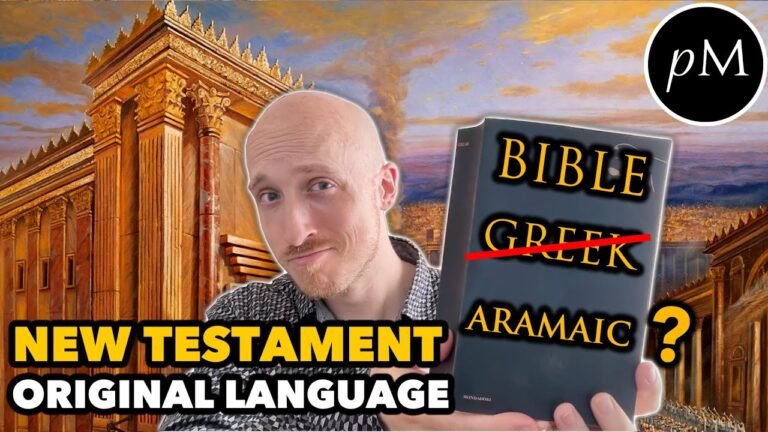The Original Languages of the Bible
The Bible, one of the most influential texts in human history, has a rich linguistic heritage that often raises the question: what was the Bible originally written in? Understanding its origins reveals a complex tapestry of languages, primarily Hebrew, Aramaic, and Greek, each contributing to the depth and nuance of its teachings. This exploration not only enhances our appreciation of the text but also sheds light on the cultural and historical contexts that shaped its formation. As we delve into the original languages of the Bible, we uncover the profound significance behind its enduring message.
In what language was the original version of the Bible written?
The Bible, a foundational text for many cultures and religions, is an anthology that showcases a rich tapestry of literary forms. Originally composed in Hebrew, Aramaic, and Koine Greek, it brings together a diverse array of writings, each contributing to its profound impact on human history. From ancient laws and moral teachings to poetic psalms and prophetic visions, these texts reflect the complexities of the human experience.
The Hebrew Bible, primarily written in Hebrew, serves as the cornerstone of the Jewish faith, encapsulating sacred narratives and religious laws. Aramaic, a language prevalent during the time of Jesus, appears in select passages, emphasizing the cultural and historical context of the New Testament. Meanwhile, the New Testament was predominantly written in Koine Greek, the lingua franca of the eastern Mediterranean, making its teachings accessible to a broader audience.
Together, these languages and genres create a multifaceted document that has inspired countless interpretations and discussions over the centuries. The Bible’s original texts not only offer spiritual guidance but also provide insight into the historical and cultural landscapes of their time, solidifying its status as a timeless and universal anthology.
Was the original Bible written on paper?
The original scriptures of the Bible were not penned on paper as we know it today. Instead, they were meticulously inscribed on scrolls, a common medium in ancient times. These scrolls, made from materials like papyrus and animal skins, were rolled up for storage and transport, reflecting the writing methods of the era.
As the demand for more accessible texts grew, the codex emerged as a revolutionary format. This early form of a book combined multiple sheets of parchment or papyrus, allowing for easier reading and portability. With one edge bound, the codex offered a practical alternative to scrolls, paving the way for the modern book.
The transition from scrolls to codices marked a significant evolution in the dissemination of biblical texts. This shift not only enhanced accessibility but also facilitated the preservation and sharing of religious teachings throughout history, influencing the way sacred scriptures were distributed and studied in subsequent generations.
What was the reason for the Bible being written in Greek?
The Bible was written in Greek primarily due to the historical context of the Jewish community in Egypt around the third century BC. As this community increasingly lost proficiency in Hebrew and Aramaic, they sought to preserve their sacred texts by translating the Hebrew Bible into Greek, their dominant language at the time. This translation not only made the scriptures accessible to a wider audience but also marked a significant cultural shift, reflecting the blending of Hellenistic influences with Jewish tradition.
Unveiling the Ancient Texts
Throughout history, ancient texts have served as invaluable windows into the past, offering insights into the cultures, beliefs, and practices of civilizations long gone. These manuscripts, often meticulously crafted by hand, reveal the thoughts and philosophies that shaped societies, providing a rich tapestry of human experience. From the epic tales of Mesopotamia to the philosophical treatises of ancient Greece, each document is a testament to the enduring quest for knowledge and understanding that transcends time.
As modern scholars delve into the study of these texts, new technologies and methodologies are transforming our approach to ancient literature. Digital tools enable us to decipher and analyze manuscripts that were once inaccessible, while interdisciplinary collaborations enrich our interpretations. This renewed interest not only highlights the significance of these artifacts in their historical context but also underscores their relevance in addressing contemporary issues. By unveiling the stories held within these ancient pages, we continue to connect with the wisdom of those who came before us, fostering a deeper appreciation for our shared human heritage.
Exploring Hebrew, Aramaic, and Greek
The rich tapestry of biblical languages—Hebrew, Aramaic, and Greek—offers a profound insight into the texts that have shaped religious thought for centuries. Hebrew, the language of the Old Testament, is characterized by its unique structure and a deep connection to the cultural and spiritual heritage of the Jewish people. Aramaic, once widely spoken across the Near East, provides vital context for understanding certain passages in the Bible, particularly those relating to the life of Jesus. Meanwhile, Greek, the language of the New Testament, opens a window into the early Christian world, revealing the nuances of theology and philosophy that influenced the development of Christianity.
Together, these languages form a triad that enriches our comprehension of sacred scriptures. Each language contributes its own flavor to the interpretation of biblical texts, allowing scholars and believers alike to engage with the scriptures on multiple levels. By exploring the linguistic intricacies and historical contexts of Hebrew, Aramaic, and Greek, we can uncover layers of meaning that enhance our spiritual journeys and deepen our appreciation for the enduring legacy of these ancient writings.
The Roots of Sacred Scripture
Sacred Scripture serves as a profound reflection of humanity’s quest for meaning, rooted in ancient traditions and divine revelation. These texts have evolved over centuries, capturing the essence of spiritual experiences and moral teachings that resonate across cultures. From the earliest oral traditions to the written word, the foundations of Sacred Scripture are embedded in the lives of those who sought to understand their existence and relationship with the divine.
At the heart of these scriptures lies a tapestry of narratives that not only convey religious doctrine but also offer timeless wisdom. They invite readers to engage with fundamental questions about life, purpose, and the nature of faith. By exploring the roots of these sacred writings, we uncover the rich historical and cultural contexts that shaped them, revealing a shared human experience that transcends boundaries and continues to inspire generations.
Understanding the original languages of the Bible—primarily Hebrew, Aramaic, and Greek—illuminates its rich historical and cultural context. This linguistic foundation not only enhances our interpretation of the text but also deepens our appreciation for its profound impact on literature, philosophy, and faith throughout the centuries. By exploring these original writings, we uncover the nuances and meanings that have shaped beliefs and narratives across generations, making the Bible not just a religious document, but a cornerstone of human expression and thought.







